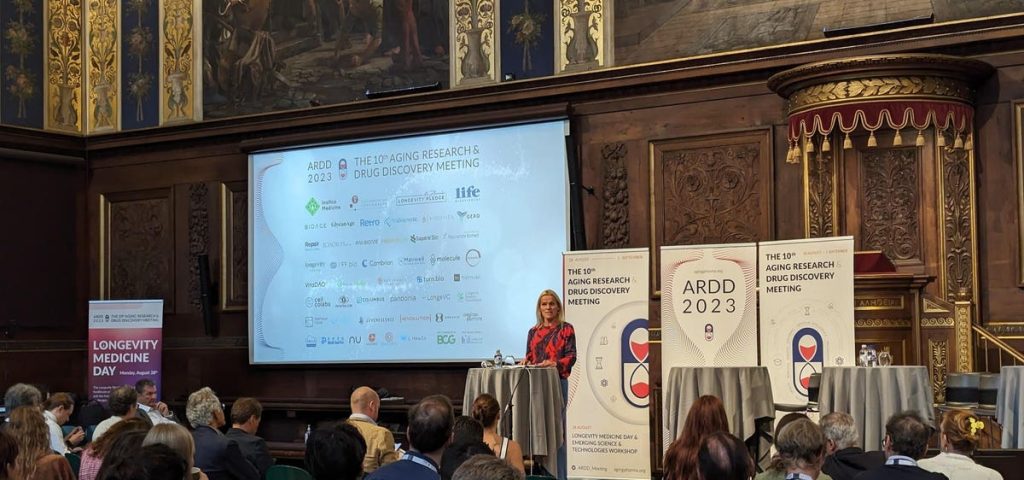On Thursday, August 31st, the 10th Aging Research and Drug Discovery (ARDD) meeting entered its fourth day. With sessions starting early in the morning and ending after 8PM every day followed by social activities including the laboratory-themed open bar staying open until past midnight, taking part in many conference activities does require a certain level of stamina. This intensity is one of the reasons why it did not feel too crowded with over seven hundred participants on site and many thousands online – many delegates spread around the venue and around the city tuning into the lectures online and having parallel meetings. And even I got a bit sick and lost my voice while testing negative for COVID every day.
Unlike the first day of the conference, which focused on longevity medicine and was geared to physicians and organizations running clinical trials, or the second day, which focused mostly on cellular senescence, the fourth day covered a broad spectrum of topics in aging research. One of the standout themes was the quest for accurate biomarkers of aging and their applications in aging research.
Aging Biomarkers Consortium Paper Published in Cell
Scientists around the world were talking about forming a consortium on aging biomarkers for a long time. For over a decade, every ARDD conference had multiple talks on biomarkers of aging and hosted several workshops designed to establish a consensus for how to measure the biological age, and which biomarkers to use to measure specific interventions. In 2022, during the Gordon Research Conference on Systems Biology of Aging chaired by the giants of the field, Vadim Gladyshev of Harvard and Steve Horvath, at that time from UCLA (now at Altos Labs), many scientists decided to collaborate on the Biomarkers of Aging Consortium. In December 2023, the consortium hosted its inaugural conference at the Buck Institute for Research on Aging. You can follow this non-profit initiative on LinkedIn. The consortium brought together the most published scientists in the field of aging biomarkers, who collaborated on the first positioning paper titled “Biomarkers of aging for the identification and evaluation of longevity interventions”. This paper got published in Cell on August 31st during the fourth day of the ARDD2023 and Vadim Gladyshev covered it in his talk on day five.
Day Four of the 10th ARDD
The morning session opened with a presentation by Dario Valenzano from Friedrich Schiller University discussing the “Evolution and Ecology of Aging,” providing a foundational understanding of how aging has evolved as a biological phenomenon. Gabor Gyülveszi of Rejuveron Life Sciences followed with a presentation on a “Multifocal Approach to Tackle Longevity,” emphasizing the need for multi-pronged strategies to address the complex issue of aging.
Alexey Moskalev, adjunct professor at George Mason University, delved into the “Science and Clinical Application of Biological Age Estimation,” highlighting the importance of biological over chronological age. Aleksandar Vojta of GlycanAge discussed the “Genetics and Epigenetics of the Glycan Clock for Biological Age,” exploring the potential of glycans as reliable biomarkers for aging.
Vittorio Sebastiano of Turn Biotechnologies presented on “Cellular and Tissue Rejuvenation through Epigenetic Reprogramming,” focusing on the transformative potential of epigenetic modifications. Boris Djordjevic, CEO of 199 Biotechnologies, spoke on “Breaking Through Longevity Barriers,” emphasizing the need for disruptive technologies and approaches.
Mette Kierkgaard: Denmark’s Commitment to Improving Senior Citizens’ Lives
After lunch, Mette Kierkgaard, the Minister for Senior Citizens in Denmark gave a thoughtful and inspiring talk about what is Denmark doing to improve the lives of senior citizens. She highlighted the importance of aging research and ensuring that senior citizens can get the latest technologies to help them prevent disease, remain healthy and productive and enjoy life longer.
It is no secret that a substantial part of the Danish economy comes from the pharmaceutical industry. And the recent popularity of Novo Nordisk’s Semaglutide is driving considerable revenue into Denmark. After her talk, I approached the minister and asked if there are any studies recent contribution of GLP-1 inhibitors on longevity. Numerous research papers speculate that GLP-1 inhibitors will be “the next metformin” and will extend lifespan in humans. I also asked why Novo Nordisk Foundation, the non-profit dedicated to the advancement of medical science, does not support the 10th ARDD conference as it is now the world’s largest industry event. But the event relies on dozens of small startups for funding. Hopefully, the Minister will help establish this connection for next year as this non-profit conference organized by the University of Copenhagen is expected to expand even further.
Morten Scheibye-Knudsen of the University of Copenhagen gave a wonderful talk covering a broad spectrum of his research studies from DNA damage and repair to cutting-edge work in artificial intelligence. One part of his talk on sex differences in aging rates grabbed substantial attention. Research from his lab and other prominent labs, including Vadim Gladyshev’s, suggests that while females generally live longer than males, and on biological clocks they age slower, they start to age earlier in life. While males start aging later in life but age very quickly at the end of life. To me, this research once again emphasized the urgency of aging research as I am approaching fifty and soon will start aging very quickly. Time to accelerate!
Nir Barzilai of Albert Einstein College of Medicine presented on “Biomarkers for Human Longevity,” emphasizing the critical role of biomarkers in aging research. Dr. Barzilai’s lectures are not only full of insights but full of unique humor designed to keep the audience engaged and make better associative memories.
Vincenzo Sorrentino of the National University of Singapore discussed “Trigonelline as a Novel NAD+ Precursor with Muscle Longevity Benefits Across Species,” offering a new avenue for muscle preservation in aging. Chieh Chen of UCLA talked about “Promoting Longevity Using Endogenous Metabolites,” providing insights into how the body’s own chemicals could be harnessed for longevity.
Shan Luo of The University of Hong Kong evaluated the “Impact of Putative Drug Targets of Metformin on Phenotypic Age and Leukocyte Telomere Length,” offering a detailed look into the genetic aspects of one of the most studied drugs in aging research.
The Famous Taurine Paper
Remember the famous “Taurine deficiency as a driver of aging” paper published in Science in June 2023? The short story is that median lifespan of taurine-treated mice increased by 10 to 12%, which is a very large number and is comparable with Rapamycin, the current champion. At the time of the writing, the paper had the Altmetric score of almost 3800 putting it in top eighty papers in the history of Science. The ARDD always features the latest and greatest and Parminder Singh of the Buck Institute presented a widely-attended talk titled “Taurine Deficiency as a Driver of Aging”. It is worthwhile noting that the second citation in the big taurine paper was the proceedings of the ARDD2020 published in Aging.
Paul Robbins of the University of Minnesota discussed “Novel Senotherapeutic Approaches to Extend Healthspan,” followed by Paul Rubin of BioAge Labs who spoke on “Muscle Aging and Healthy Weight Loss.” Sara Wickström of the Max Planck Institute presented on “Mechanical Regulation of Stem Cell State and Aging,” offering a novel perspective on how physical forces can impact cellular aging. Joe Baur of the University of Pennsylvania discussed “Manipulating Mitochondrial NAD,” while John Speakman of Shenzhen Institutes of Advanced Technology focused on “Stepping Stones Towards Anti-Ageing Drug Discovery.” Eric Verdin, CEO of the Buck Institute for Research on Aging concluded the scientific talks with a presentation on “Human Immune Aging.”
Ten Years of ARDD – Cake Cutting Ceremony
During the break, the chairs unveiled the three giant cakes designed, delivered, and assembled by the world famous Danish bakery, “La glacé”. This bakery was a great choice for the ARDD conference, since it is also among Europe’s oldest. The bakery was founded in 1870. In the spirit of the conference, the cakes were made of fresh berries.
Richard Faragher of the University of Brighton discussed “Therapeutic Opportunities Presented by Modulation of Cellular Senescence,” followed by Marco Quarta of Rubedo Life Sciences who spoke on “Therapeutic Targeting of Cellular Senescence Heterogeneity Across Age-Related Diseases.” Laura Niedernhofer of the University of Minnesota presented on “Pre-Clinical Models for Testing Geroprotectors,” while Valter Longo of USC Davis School of Gerontology discussed “Fasting Mimicking Diets, Multi-System Regeneration and Longevity.” James Peyer of Cambrian Biopharma talked about “Bringing a Pipeline to Patients,” and Rafael de Cabo of the National Institutes of Health concluded the day with “Predictions and Associations with Lifespan and Healthspan Outcomes in SLAM.”
Billionaires, Nature Editors, and Longevity Activists Sighted
The presence of high-profile investors like Sami Sagol and Jim Mellon, added a layer of financial gravitas to the scientific discussions. Sami Sagol, a long-time friend of Dr. Nir Barzilai, avoids publicity but is often spotted at the high-level scientific conferences some of which he supports. He did not directly support the 10th ARDD financially but added to the unique spirit of the conference by interacting with the scientists some of which he supports through the Sagol Institute for Longevity Research.
It was difficult not to spot Jim Mellon, the founder of Juvenescence and the author of Juvenescence. There was always a small cloud forming around him. Jim developed a reputation in the pharmaceutical industry by investing early in Medivation (sold to Pfizer for approxomately $14 Billion) and Biohaven pharmaceuticals (sold to Pfizer for over $11 Billion). Hence, many aspiring startups and scientists were trying to reach out for advice or support.
Editors from top scientific journals, including Lisa Melton from Nature Biotechnology and Peter Kirkpatrick from Nature Reviews Drug Discovery, were also in attendance, contributing to the unique atmosphere where cutting-edge academic science meets credible, evidence-based biotechnology and pharmaceutical science.
Longevity Biotechnology Association (LBA) Reception
The boom in aging research and its use as a platform for drug discovery, prompted the formation of the Longevity Biotechnology Association (LBA), which recently published a seminal paper with the definition of a Longevity Biotechnology Company.
The LBA members led by its executive director Risa Starr, convened at a restaurant near the conference to discuss the recent advances, socialize and recruit new members.
Aubrey de Grey, the long-term longevity advocate now running the Longevity Escape Velocity Foundation attended as a delegate, signaling the conference’s importance and his own commitment to combination trials of geroprotective therapies in mice.
Danish Longevity Sauna Club
One of the conference sponsors was Glaecier Sauna, a unique floating sauna with its own swimming pool built by professional industrial designers interested in longevity. On Thursday, speakers and high-tier sponsors were invited to experience the hormetic experience of high and low temperatures.
This was a rare opportunity to discuss science in social setting and draw inspiration from the fit colleagues who understand the importance of building muscle.
Science Lab-inspired Open Bar
In its customary tradition, the conference ended with a gathering at Bar7, which I hope could be re-branded into Lab7 for the duration of the conference next year, with an open bar.
Unfortunately, I got to the bar around midnight when most of the delegates went home but a healthy crowd still remained both inside and outside the establishment. This year, most of the waiters wore lab coats and the drinks menu was inspired by aging research.
Read the full article here









